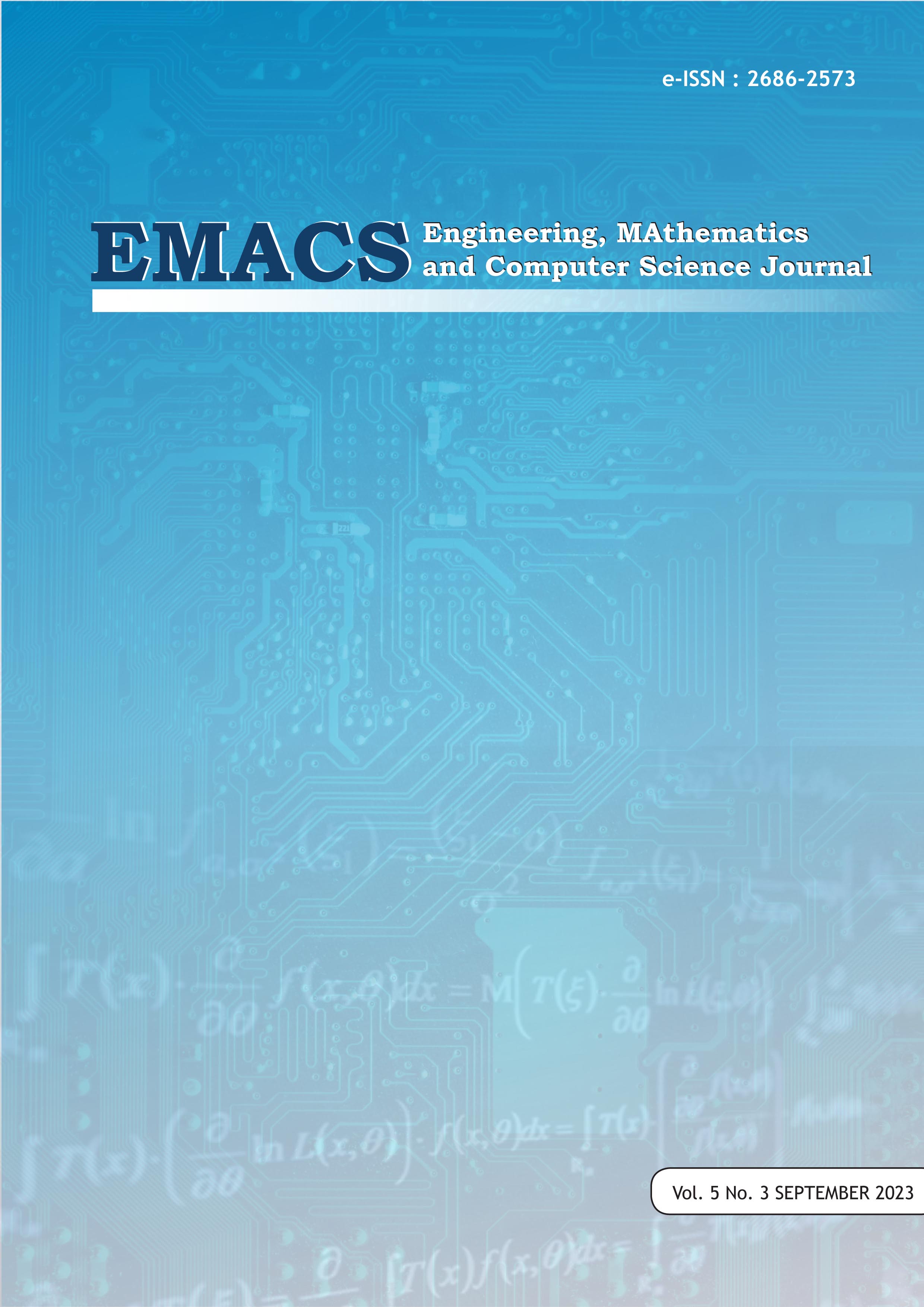Structural Time Series Model using Hamiltonian Monte Carlo for Rice Price
DOI:
https://doi.org/10.21512/emacsjournal.v5i3.9903Keywords:
Structural, Time Series, Hamiltonian, Rice PriceAbstract
Although forecasts of future events are simply uncertain, predicting is one of the most important aspects of future planning. Accurate rice price predictions tend to be helpful for wholesalers, producers, and farmers to develop plans and strategies to reduce the risks that can be faced. Structural time series models are the most plausible alternative for long-term forecasting. This paper proposes an alternate method for modeling average rice prices using structural time series along with Bayesian parameter inference via Hamiltonian Monte Carlo (HMC). The model has been built using the monthly average wholesale rice price from January 2010 to December 2019. For working out both structural time series and HMC, the TensorFlow Probability Library was used. Linear trend, seasonal, and autoregressive components were combined as an additive model to the structural time model. The proposed Hamiltonian parameter produces an optimal acceptance rate. Their trace plot was used to diagnose the convergence of their chain. One of the predictive accuracy of models was assessed using the mean absolute percent error (MAPE). Through both single and multiple chain iterations, the prediction accuracy of a year-ahead is highly accurate, with MAPE less than 2%. Long-term iteration draws during Hamiltonian Monte Carlo should be considered when attempting to achieve more convergence.
References
Almarashi, A. M., & Khan, K. (2020). Bayesian Structural Time Series. Nanoscience and Nanotechnology Letters, 12(1), 54–61. https://doi.org/10.1166/nnl.2020.3083
AL-Moders, A. H., & Kadhim, T. H. (2021). Bayesian Structural Time Series for Forecasting Oil Prices. Ibn AL- Haitham Journal For Pure and Applied Sciences, 34(2), 100–107. https://doi.org/10.30526/34.2.2631
Anandyani, A. R., Astutik, D. K. A., Bariroh, N., & Indrasetianigsih, A. (2021). Prediksi Rata-Rata Harga Beras yang Dijual oleh Pedagang Besar (Grosir) Menggunakan Metode Arima Box Jenkins. Teknosains: Media Informasi Sains dan Teknologi, 15(2), 151. https://doi.org/10.24252/teknosains.v15i2.17721
Aryani, D. (2021). Instrumen Pengendalian Harga Beras di Indonesia: Waktu Efektif yang Dibutuhkan. Jurnal Pangan, 30(2). https://doi.org/10.33964/jp.v30i2.538
Betancourt, M. (2017). A Conceptual Introduction to Hamiltonian Monte Carlo. https://doi.org/10.48550/ARXIV.1701.02434
Cordeiro, C. E. Z., Stutz, L. T., Knupp, D. C., & Matt, C. F. T. (2022). Generalized Integral Transform and Hamiltonian Monte Carlo for Bayesian structural damage identification. Applied Mathematical Modelling, 104, 243–258. https://doi.org/10.1016/j.apm.2021.11.026
Fajari, D. A., Abyantara, M. F., & Lingga, H. A. (2021). Peramalan Rata-Rata Harga Beras pada Tingkat Perdagangan Besar Atau Grosir Indonesia dengan Metode Sarima (Seasonal Arima). Jurnal Agribisnis Terpadu, 14(1), 88. https://doi.org/10.33512/jat.v14i1.11460
Feroze, N. (2020). Forecasting the patterns of COVID-19 and causal impacts of lockdown in top five affected countries using Bayesian Structural Time Series Models. Chaos, Solitons & Fractals, 140, 110196. https://doi.org/10.1016/j.chaos.2020.110196
Gentle, J. E. (2009). Computational statistics. Springer.
Kramer, A., Calderhead, B., & Radde, N. (2014). Hamiltonian Monte Carlo methods for efficient parameter estimation in steady state dynamical systems. BMC Bioinformatics, 15(1), 253. https://doi.org/10.1186/1471-2105-15-253
Nafi’iyah, N., & Khudori, M. (2022). Rice Price Prediction System Based on Rice Quality and Milling Level using Multilayer Perceptron. Jurnal Informatika Universitas Pamulang, 7(1), 39–43. https://doi.org/10.32493/informatika.v7i1.15326
Natasya, Musdalifah, S., & Andri. (2021). Prediksi Harga Beras Di Tingkat Perdagangan Besar Indonesia Menggunakan Algoritma Backpropagation. Jurnal Ilmiah Matematika Dan Terapan, 18(2), 148–159. https://doi.org/10.22487/2540766X.2021.v18.i2.15688
Neal, R. M. (2011). MCMC using Hamiltonian dynamics. https://doi.org/10.1201/b10905
Ohyver, M., & Pudjihastuti, H. (2018). Arima Model for Forecasting the Price of Medium Quality Rice to Anticipate Price Fluctuations. Procedia Computer Science, 135, 707–711. https://doi.org/10.1016/j.procs.2018.08.215
Ramadhani, F., Sukiyono, K., & Suryanty, M. (2020). Forecasting of Paddy Grain and Rice’s Price: An ARIMA (Autoregressive Integrated Moving Average) Model Application. SOCA: Jurnal Sosial, Ekonomi Pertanian, 14(2), 224. https://doi.org/10.24843/SOCA.2020.v14.i02.p04
Sanjaya, F. I., & Heksaputra, D. (2020). Prediksi Rerata Harga Beras Tingkat Grosir Indonesia dengan Long Short Term Memory. JATISI (Jurnal Teknik Informatika dan Sistem Informasi), 7(2), 163–174. https://doi.org/10.35957/jatisi.v7i2.388
Shidiq, B. G. A., Furqon, M. T., & Muflikhah, L. (2022). Prediksi Harga Beras menggunakan Metode Least Square. Jurnal Pengembangan Teknologi Informasi dan Ilmu Komputer, 6(3), 1149–1154.
Sulpaiyah, S., Bahri, S., & Harsyiah, L. (2022). Peramalan Harga Beras dengan Metode Double Exponential Smoothing dan Fuzzy Time Series (Study Kasus: Harga Beras di Kota Mataram). Eigen Mathematics Journal, 58–69. https://doi.org/10.29303/emj.v5i2.123.
Downloads
Published
How to Cite
Issue
Section
License
Copyright (c) 2023 Engineering, MAthematics and Computer Science Journal (EMACS)

This work is licensed under a Creative Commons Attribution-ShareAlike 4.0 International License.
Authors who publish with this journal agree to the following terms:
- Authors retain copyright and grant the journal right of first publication with the work simultaneously licensed under a Creative Commons Attribution License - Share Alike that allows others to share the work with an acknowledgment of the work's authorship and initial publication in this journal.
- Authors are able to enter into separate, additional contractual arrangements for the non-exclusive distribution of the journal's published version of the work (e.g., post it to an institutional repository or publish it in a book), with an acknowledgment of its initial publication in this journal.
- Authors are permitted and encouraged to post their work online (e.g., in institutional repositories or on their website) prior to and during the submission process, as it can lead to productive exchanges, as well as earlier and greater citation of published work.
USER RIGHTS
All articles published Open Access will be immediately and permanently free for everyone to read and download. We are continuously working with our author communities to select the best choice of license options, currently being defined for this journal as follows: Creative Commons Attribution-Share Alike (CC BY-SA)





